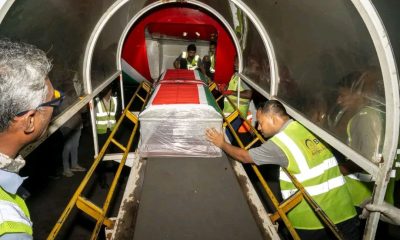Investigations
Kenya Grapples with 309 Criminal Gangs

There are 309 criminal gangs in the country with Mombasa and Nairobi having the highest number -73 and 56, respectively –of such gangs.
A recent survey by the National Crime Research Centre (NCRC) released on Wednesday says the gangs are distributed across the counties variably in terms of growth in membership, spread across various counties, resilience and being most dreaded.
“Key indicators of proliferation included frequent reports of gang-related crimes, increased violence, and growing gang influence in youth groups. Most gang members were young males with histories of substance abuse and limited education,” the NCRC report states.
The gangs engage in criminal activities such as robberies, extortion, drug peddling and trafficking, political violence, and murder, with far-reaching implications on the country’s development besides presenting a growing challenge to national security.
Violent attacks
Their operations are also characterized by violent attacks and intimidation, and despite the numerous government interventions, these groups continue to adapt, evade law enforcement, and expand their influence.
The criminal gangs that were leading in terms of their presence in at least four counties are Gaza/Gaza Family (in 8 out of 11 counties), 42 Brothers (in six counties), Wakali Wao (in 5 counties), and Panga Boys, Chafu/Squad Chafu/Gang Chafu and Mungiki (each in four counties).
The gangs were found to have infiltrated multiple sectors, expanded their criminal activities, adopted sophisticated operational tactics, and gained resilience through community complicity.
“These dynamics made gang-related crime a persistent and complex security threat. Criminal gangs were found to have permeated multiple sectors, with the most affected being security, drug trade, and public transport,” the report states.
The sectors include security (90.8 percent); drugs and narcotics trade (70.5 percent); business and entrepreneurship (62.0 percent); public transport service; political; information and communication technology; land and natural resources; and financial sectors among others.
Peer pressure
“Recruitment was primarily through peer influence, targeting vulnerable youth, and financial incentives. The key factors driving youth involvement included peer pressure, unemployment, drug exposure, and poor family support systems,” the report states.
The persistence of gangs was linked to peer pressure and influence; vulnerabilities associated with high unemployment and poverty, availability of illegal drugs, broken or poor social and family support systems, and inadequate formal education among youth.
At least 84.6 percent of the sample respondents acknowledged complicity among local community members (drawn from peers, family members and larger community members) especially through failure to report crimes, offering protection and normalizing gang activities had contributed to gang resilience.
Others factors are political exploitation, community cultural and social tolerance of criminal gangs, and underdevelopment and marginalization.
The report said corruption among rogue government officials, including security and law enforcement officers, inadequate social services, weak security policing of criminal gangs and poor coordination among existing criminal justice agencies also contribute to the menace.
“Ready markets for stolen items sold as second-hand items, weak prosecution of criminal gang members and inadequately sustained youth empowerment initiatives are also key driving factors for persistence of the gangs,” the report states.
Equally, corruption within the criminal justice system and fear of retaliation further exacerbated the problem.
The survey examined the proliferation, activities, contributing factors, and mitigation measures concerning criminal gangs in Kenya and was undertaken in 11 counties including Nairobi, Mombasa, Kilifi, Nakuru, Bungoma, Kwale, Kiambu, Machakos, Kisumu, Busia and Garissa.
The distribution of the number of known criminal gangs across the survey counties was Mombasa (73), Nairobi (56), Kilifi (47), Garissa (31), Kwale (29), Busia (29), Bungoma (28), Machakos (28), Nakuru (27), Kisumu (22), and Kiambu (20).
Kenya Insights allows guest blogging, if you want to be published on Kenya’s most authoritative and accurate blog, have an expose, news TIPS, story angles, human interest stories, drop us an email on [email protected] or via Telegram
-

 News2 weeks ago
News2 weeks agoPlane Carrying Raila Odinga Becomes World’s Most Tracked Flight as Kenya Airways Honors Him With Special Call Sign ‘RAO001’
-

 Business1 week ago
Business1 week agoSafaricom’s Sh115 Trillion Data Breach Scandal: How Kenya’s Telecom Giant Sold Out 11.5 Million Customers
-

 Investigations4 days ago
Investigations4 days agoDEATH TRAPS IN THE SKY: Inside the Sordid World of West Rift Aviation’s Deadly Corruption Cartel
-

 Business2 weeks ago
Business2 weeks agoBillionaire: Inside Raila Odinga’s Vast Wealth
-

 News2 weeks ago
News2 weeks agoI Used To Sleep Hungry, But Today I Employ The Same People Who Once Laughed At My Poverty
-

 News2 weeks ago
News2 weeks agoMaurice Ogeta, Raila’s Bodyguard: The Shadow Who Became The Story
-

 News2 weeks ago
News2 weeks agoCourt Fines Orengo’s Law Firm For Wrongful Dismissal of Lawyer
-

 Investigations21 hours ago
Investigations21 hours agoEXPOSED: The Visa Cartel Bleeding Kenyans Dry – How Immigration Boss Turned Government Office Into Personal Cash Cow













